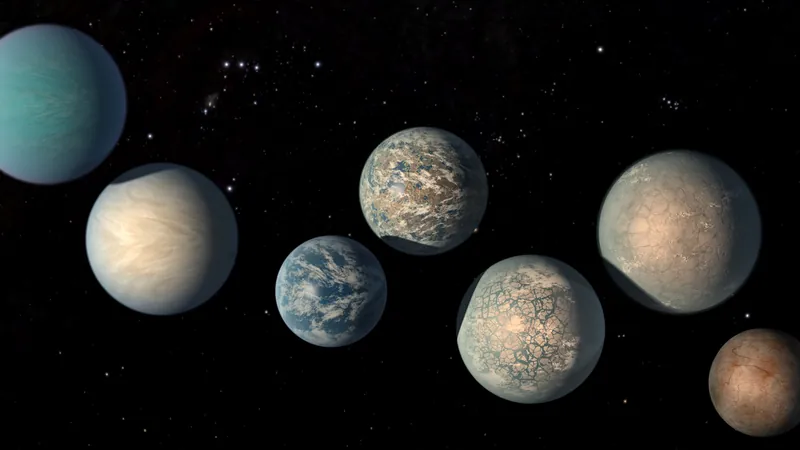
Astronomers on the Brink of Directly Imaging Exoplanets with Groundbreaking Quantum Tech
2025-05-22
Author: Rajesh
Unlocking the Mysteries of the Cosmos
A revolutionary team of scientists is creating a game-changing "quantum-sensitive" device aimed at capturing direct images of Earth-like exoplanets—an achievement thought to be nearly unattainable by astronomers. This leap in imaging capability could reshape our understanding of nearby worlds.
From Telescopes to Quantum Mechanics
Since the advent of the telescope in 1608, humanity's grasp of the cosmos has expanded tremendously. Initial telescope images were fuzzily revealing craters on the moon and the four largest moons of Jupiter. Today, modern marvels like the James Webb Space Telescope (JWST) have drastically upgraded how we perceive the universe.
Modern astronomers utilize sophisticated tools called coronagraphs, which enable them to filter out blinding light from stars, allowing the detection of distant celestial objects—over a billion times fainter than their stellar counterparts.
Pushing the Boundaries of Imaging Technology
Now, researchers like Nico Deshler, a Ph.D. student at the University of Arizona, and Itay Ozer from the University of Maryland, seek to enhance coronagraph technology using principles of quantum mechanics. Their goal? To directly image exoplanets by exceeding the traditional resolution limits imposed by current telescopes.
The diffraction limit, which typically dictates how small an object can be clearly imaged, presents a challenge: building larger telescopes is complicated and costly. Thus, innovative sub-diffraction imaging methods are vital.
Revolutionizing Exoplanet Detection with Quantum Insights
The team has designed a groundbreaking "quantum-level" coronagraph capable of sorting light to capture faint exoplanet signals lost in the glare of their host stars. By utilizing a device that sorts light based on spatial modes, they can effectively filter out starlight, focusing on the elusive light emitted by exoplanets.
This method operates by routing incoming photons to different regions based on their spatial modes, a concept crucial for enhancing the clarity of exoplanet detection. This is not just post-processing; it’s a proactive technique that maximizes the photons from exoplanets before they even reach a detector.
Encouraging Progress in Lab Tests
Initial lab assessments show promise, with the device successfully detecting exoplanets very close to bright stars—significantly beyond what current technology can manage. The researchers have achieved detection accuracy that often spans within just a few percent of theoretical limits.
A Vision for the Future of Astronomy
Looking ahead, the team believes that the technology to create their quantum-enhanced coronagraph already exists. With continued refinement, they're on a path to develop a deployable system that could transform our capability to observe worlds beyond our solar system.
To truly reveal the secrets of exoplanets—their atmospheres, compositions, and potential signs of life—advanced manufacturing techniques will be essential. As they aim for nearly perfect photon isolation, methods like photolithography and micromachining will play a critical role.
The Future Awaits: Potential to Discover New Worlds
The research holds promise for future telescope missions, such as the Habitable Worlds Observatory, that may redefine our understanding of life in the cosmos. Direct imaging through this innovative approach could provide key insights into exoplanet atmospheres and potential biosignatures, opening a new frontier in astronomical exploration.
Deshler and Ozer underscore that while this technology could greatly enhance the toolkit for discovering and characterizing faint exoplanets, it will complement existing methods like transits and gravitational microlensing rather than replace them. The journey into the depths of the universe continues, propelled by the pursuit of knowledge.



 Brasil (PT)
Brasil (PT)
 Canada (EN)
Canada (EN)
 Chile (ES)
Chile (ES)
 Česko (CS)
Česko (CS)
 대한민국 (KO)
대한민국 (KO)
 España (ES)
España (ES)
 France (FR)
France (FR)
 Hong Kong (EN)
Hong Kong (EN)
 Italia (IT)
Italia (IT)
 日本 (JA)
日本 (JA)
 Magyarország (HU)
Magyarország (HU)
 Norge (NO)
Norge (NO)
 Polska (PL)
Polska (PL)
 Schweiz (DE)
Schweiz (DE)
 Singapore (EN)
Singapore (EN)
 Sverige (SV)
Sverige (SV)
 Suomi (FI)
Suomi (FI)
 Türkiye (TR)
Türkiye (TR)
 الإمارات العربية المتحدة (AR)
الإمارات العربية المتحدة (AR)